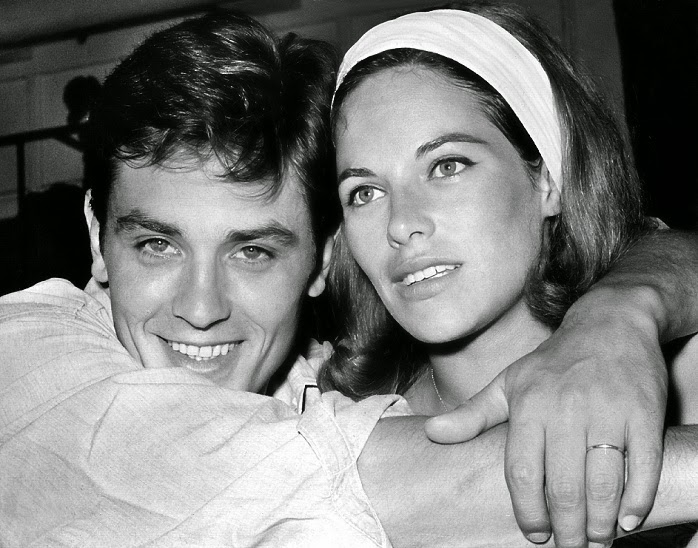Anna Karina's Look in Vivre Sa Vie
This particular look of Anna Karina's, who was Jean-Luc Godard's muse and wife at the time of this film, Vivre sa vie
(1962), embodies the French New Wave as one source of inspiration that gets
revisited by fashion designers time and time again. Danish born Anna Karina was one of the style figures of the French New Wave. In Vivre sa vie,
with her porcelain skin, feline eyes, Louise Brooks hair style and chic
outfits, always smoking (always a plus!), Anna is without a shadow of a doubt a
young woman of Paris. In her effortlessly thrown cardigan, knee-length
skirt, boucle coat and kitten heels, and especially with that careless
poise, she channels the Chanel look more accurately than an ad campaign
for the brand. An interesting fact is that a chance meeting with Coco
Chanel was what made her change her name from Hanne Karin Bayer,
resulting in the Anna Karina we know today.
Godard conceived Vivre sa vie as a showcase for Anna Karina's talent; an attempt also, perhaps, to save their marriage through cinematic collaboration. In the event, she does not disappoint, giving a performance both truthful and deeply affecting. Godard, a man still clearly in love, frames her like a painter, successfully capturing her ravishing beauty and her fragile vulnerability. Despite their mutual achievement and the acclaim it brought, however, Karina was resentful about her appearance in the film. "She was furious afterwards," Godard recalled, "because she thought I had made her look ugly, that I had done her a considerable wrong by having made this film; that was the beginning of our breakup." A film that should have brought them closer together drove them further apart.
Profoundly wounded himself by his wife's infidelity, Godard derived much of the opening scene’s dialogue from their own relationship. She warns him, "If we get back together, I’ll betray you again," and blames him for preventing her from fulfilling her ambitions as an actress. In the film’s eleventh sequence, Nana's young lover reads to her from Edgar Allan Poe's story "The Oval Portrait". It is not the actor's voice on screen we hear but Godard himself who recites the passages. The story concerns a painter who grows so obsessed with a painting depicting his wife that he pays no attention to the real woman. When he is finished he looks at the work and exclaims, "This is indeed life itself!" Then turns to see his bride, and discovers that she has died and her spirit has transferred into the lifelike painting. The inference is clear; Godard saw it as fate that he would lose the woman he loved as the price of their artistic collaboration...
"I think we're always responsible for our actions. We're free. I raise my hand – I'm responsible. I turn my head to the right – I'm responsible. I'm unhappy – I'm responsible. I smoke a cigarette – I'm responsible. I shut my eyes – I'm responsible. I forget that I'm responsible, but I am. I told you escape is a pipe dream. After all, everything is beautiful. You only have to take an interest in things, see their beauty. It's true. After all, things are just what they are. A face is a face. Plates are plates. Men are men. And life...is life."
Vivre Sa Vie (1962)
Jean-Luc Godard
Godard conceived Vivre sa vie as a showcase for Anna Karina's talent; an attempt also, perhaps, to save their marriage through cinematic collaboration. In the event, she does not disappoint, giving a performance both truthful and deeply affecting. Godard, a man still clearly in love, frames her like a painter, successfully capturing her ravishing beauty and her fragile vulnerability. Despite their mutual achievement and the acclaim it brought, however, Karina was resentful about her appearance in the film. "She was furious afterwards," Godard recalled, "because she thought I had made her look ugly, that I had done her a considerable wrong by having made this film; that was the beginning of our breakup." A film that should have brought them closer together drove them further apart.
Profoundly wounded himself by his wife's infidelity, Godard derived much of the opening scene’s dialogue from their own relationship. She warns him, "If we get back together, I’ll betray you again," and blames him for preventing her from fulfilling her ambitions as an actress. In the film’s eleventh sequence, Nana's young lover reads to her from Edgar Allan Poe's story "The Oval Portrait". It is not the actor's voice on screen we hear but Godard himself who recites the passages. The story concerns a painter who grows so obsessed with a painting depicting his wife that he pays no attention to the real woman. When he is finished he looks at the work and exclaims, "This is indeed life itself!" Then turns to see his bride, and discovers that she has died and her spirit has transferred into the lifelike painting. The inference is clear; Godard saw it as fate that he would lose the woman he loved as the price of their artistic collaboration...
"I think we're always responsible for our actions. We're free. I raise my hand – I'm responsible. I turn my head to the right – I'm responsible. I'm unhappy – I'm responsible. I smoke a cigarette – I'm responsible. I shut my eyes – I'm responsible. I forget that I'm responsible, but I am. I told you escape is a pipe dream. After all, everything is beautiful. You only have to take an interest in things, see their beauty. It's true. After all, things are just what they are. A face is a face. Plates are plates. Men are men. And life...is life."
Vivre Sa Vie (1962)
Jean-Luc Godard






yuogdfgh934dfd
ReplyDeletegolden goose outlet
golden goose outlet
golden goose outlet
golden goose outlet
golden goose outlet
golden goose outlet
golden goose outlet
golden goose outlet
golden goose outlet
golden goose outlet